Renault KOLEOS 2010 Manual

KOLEOS
DRIVER’S HANDBOOK
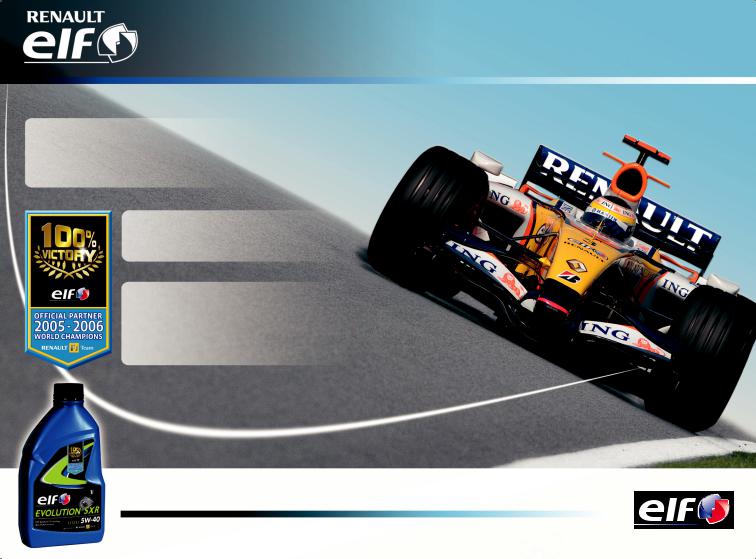
ELF is developing a complete range of lubricants for RENAULT: engine oils, manual and automatic transmission oils.
These are very high-technology lubricants stimulated by applied research in Formula One.
This range is updated with RENAULT’s engineering teams to perfectly meet the specific needs of RENAULT vehicles.
►ELF lubricants are a major factor in your vehicle’s performance.



 recommends ELF
recommends ELF
Important: to optimize engine operation the use of a lubricant may be restricted to certain vehicles. Please refer to the maintenance documentation.
RENAULT recommends the approved ELF lubricants for your oil changes and top-ups. Contact your RENAULT representative or visit the site: www.lubricants.elf.com
The oil born in Formula One
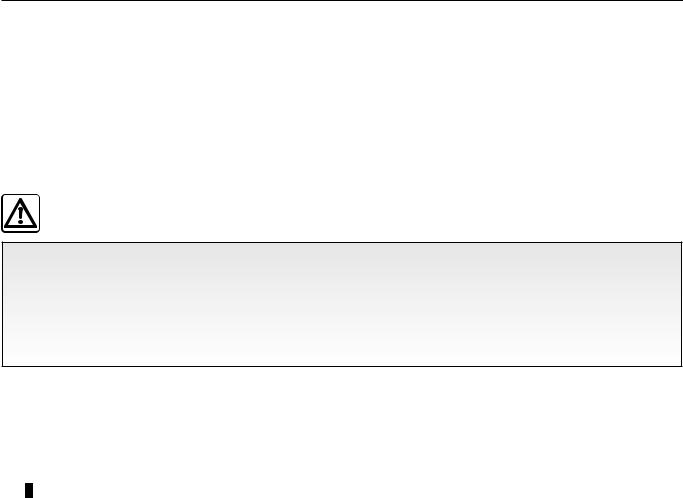
Welcome to your new vehicle
This Driver’s Handbook contains the information necessary:
–for you to familiarise yourself with your vehicle, to use it to its best advantage and to benefit fully from the all the functions and the technical developments it incorporates.
–to ensure that it always gives the best performance by following the simple, but comprehensive advice concerning regular maintenance.
–to enable you to deal quickly with minor faults not requiring specialist attention.
It is well worth taking a few minutes to read this handbook to familiarise yourself with the information and guidelines it contains about the vehicle and its functions and new features. If certain points are still unclear, our Network technicians will be only too pleased to provide you with any additional information.
The following symbol will help you when reading this handbook:
To indicate a hazard, danger or safety recommendation.
The descriptions of the models given in this handbook are based on the technical specifications at the time of writing. This handbook covers all items of equipment (both standard and optional) available for these models but whether or not these are fitted to the vehicle depends on the version, options selected and the country where the vehicle is sold.
This handbook may also contain information about items of equipment to be introduced later in the model year.
Throughout the manual, the “approved Dealer” is your RENAULT Dealer.
Enjoy driving your new vehicle.
Translated from French. Copying or translation, in part or in full, is forbidden unless prior written permission has been obtained from the vehicle manufacturer.
0.1

0.2

C O N T E N T S
Sections
Getting to know your vehicle ...............................
Driving ...................................................................
Your comfort .........................................................
Maintenance ..........................................................
Practical advice .....................................................
Technical specifications ......................................
Alphabetical index ................................................
1
2
3
4
5
6
7
0.3

0.4

Section 1: Getting to know your vehicle
RENAULT cards: general information, use, deadlocking . . . . . . . . . . . . . . . . . |
1.2 |
|
||
Doors. . . . . . . . . . . . . . . . . . . . . . . . . . . . . . . . . . . . . |
1.9 |
|
||
Automatic locking of opening elements when driving. . . . . . . . . . . . . . . . . . . |
1.13 |
|
||
|
||||
Headrests/Seats. . . . . . . . . . . . . . . . . . . . . . . . . . . . . . . . . |
1.14 |
|
||
Seat belts. . . . . . . . . . . . . . . . |
. . . . |
. . . . . . . . . . . . . . . . . . . . . . . . . . . . . . . . . . . . . . . . . . . . . . . . . . |
1.18 |
|
|
|
|
||
to the rear seat belts . . . . . . . . . . . . . . . . . . . . . . . . . . . . |
1.20 |
|
||
Additional methods of restraint:. . . . . . . . . . . . . . . . . . . . . . . . . . . |
1.22 |
|
||
to the front seat belts. . . . . . . . . . . . . . . . . . . . . . . . . . . . |
1.22 |
|
||
to the rear seat belts . . . . . . . . . . . . . . . . . . . . . . . . . . . . |
1.26 |
|
||
side protection. . . . . . . . . . . . . . . . . . . . . . . . . . . . . . . |
1.27 |
|
||
Child safety: general information. . . . . . . . . . . . . . . . . . . . . . . . . . . |
1.29 |
|
||
choosing a child seat mounting. . . . . . . . . . . . . . . . . . . . . . . . |
1.32 |
|
||
fitting a child seat. . . . . . . . . . . . . . . . . . . . . . . . . . . . . . |
1.34 |
|
||
deactivating/activating the front passenger airbags. . . . . . . . . . . . . . . . . |
1.37 |
|
||
Driving position. . . . . . . . . . . . . . . . . . . . . . . . . . . . . . . . . |
1.40 |
|
||
Warning lights. . . . . . . . . . . . . . . . . . . . . . . . . . . . . . . . . . |
1.44 |
|
||
Instrument panel. . . . . . . . . . . . . . . . . . . . . . . . . . . . . . . . . |
1.48 |
|
||
trip computer and warning system. . . . . . . . . . . . . . . . . . . . . . . |
1.50 |
|
||
Clock and exterior temperature. . |
. . . . . . . . . . . . . . . . . . . . . . . . . |
1.60 |
|
|
Steering wheel. . . . . . . . . . . . . . . . . . . . . . . . . . . . . . . . . . |
1.61 |
|
||
Power-assisted steering . . . . . . . . . . . . . . . . . . . . . . . . . . . . . . |
1.61 |
|
||
Rear-view mirrors . . . . . . . . . . . . . . . . . . . . . . . . . . . . . . . . |
1.62 |
|
||
Audible and visual signals. . |
. . . . . . . . . . . . . . . . . . . . . . . . . . . |
1.63 |
|
|
Exterior lighting and signals. . |
. . . . |
. . . . . . . . . . . . . . . . . . . . . . . . . . . . . . . . . . . . . . . . . . . . . . . . . . |
1.64 |
|
Electric beam height adjustment. . . . . . . . . . . . . . . . . . . . . . . . . . . |
1.67 |
|
||
Front windscreen wash/wiper. . . . . . . . . . . . . . . . . . . . . . . . . . . . |
1.68 |
|
||
Rear windscreen wash/wiper. . |
. . . . |
. . . . . . . . . . . . . . . . . . . . . . . . . . . . . . . . . . . . . . . . . . . . . . . . . |
1.70 |
|
Fuel tank. . . . . . . . . . . . . . . . . . . . . . . . . . . . . . . . . . . . |
1.71 |
|
||
1.1

RENAULT cards: general information (1/2)
1 |
2 |
3 |
4 |
5 |
1Unlocking the doors and the tailgate;
2Locking the doors and the tailgate;
3Switching on the lighting remotely;
4Unlocking/locking the tailgate;
5Integrated key.
The RENAULT card is used for:
–locking and unlocking the doors and tailgate (refer to the following pages);
–depending on the vehicle, automatically closing the electric windows and sunroof remotely (see the information on "Electric windows" and "Electric sunroof" in Section 3);
–switching on the vehicle lighting remotely (refer to the following pages);
–starting the engine (refer to the information on "Starting the engine" in Section 2).
Battery life
Make sure that the correct battery type is being used, and that the battery is in good condition and inserted correctly. Its service life is approximately two years: replace it when the message "Low card battery" appears on the instrument panel (refer to the information on the "RENAULT card: Battery" in Section 5).
RENAULT card operating range
This varies according to the surroundings: It is important to make sure when handling the RENAULT card that you do not lock or unlock the doors by inadvertently pressing the buttons.
When the battery is flat, you can still lock/unlock and start your vehicle. Refer to the information on “Locking/unlocking the doors” in Section 1 and “Starting the engine” in Section 2.
Driver’s responsibility
Never leave your vehicle  with the Renault card inside and never leave a child (or a pet) unsupervised, even for a
with the Renault card inside and never leave a child (or a pet) unsupervised, even for a
short while.
They may pose a risk to themselves or to others by starting the engine, activating equipment such as the electric windows or by locking the doors.
Risk of serious injury.
1.2

RENAULT cards: general information (2/2)
5 |
6 |
Integrated key 5
The integrated key is used to lock or unlock the front left-hand door if the RENAULT card does not work:
–when the RENAULT card battery is drained, discharged battery, etc.
–use of devices using the same frequency as the card;
–if the vehicle is located in a zone of high electromagnetic radiation.
Access to key 5
Press button 6 and pull on key 5 then release the button.
Using the key
Refer to the information on "Locking/ unlocking the doors".
Once you have accessed the vehicle using the integrated key, replace it in its housing in the RENAULT card, then insert the RENAULT card into the card reader to start the vehicle.
Advice
Avoid leaving the card in hot, cold or humid areas.
Do not store the RENAULT card in an area where it may accidentally become bent or damaged: this may occur if, for example, it is sat on when placed in the back pocket of a garment.
Replacement: need for an additional RENAULT Card
If you lose your RENAULT card or require another, you can obtain one from an approved dealer.
If a RENAULT card is replaced, it will be necessary to take the vehicle and all of its RENAULT cards to an approved dealer to initialise the system.
You can use up to four RENAULT cards per vehicle.
1.3
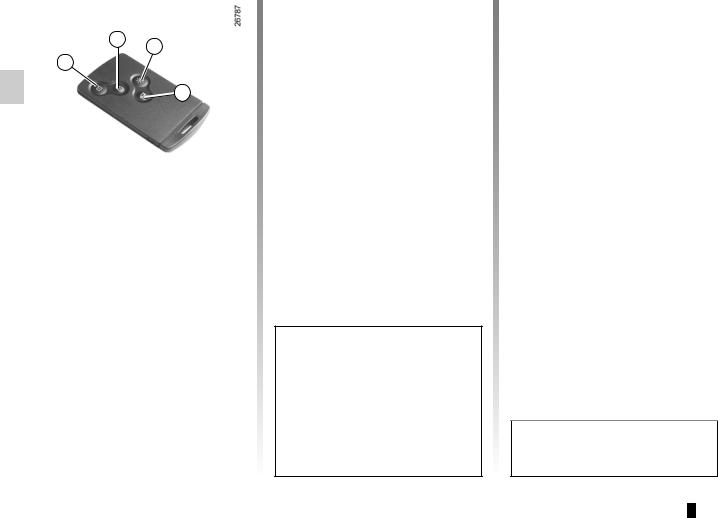
REMOTE CONTROL RENAULT CARDS : use
2 |
3 |
|
1 |
||
|
4 |
Unlocking the doors
Press unlocking button 1.
The hazard warning lights flash once to indicate that the doors have been unlocked.
Locking the doors
Press the locking button 2.
The hazard warning lights flash twice to indicate that the doors have locked: if a door or the boot is open or not properly shut, or if a RENAULT card is still in the reader, the doors and boot quickly lock then unlock and the hazard warning lights and indicator lights do not flash.
Unlocking/locking the tailgate only
Press button 4 to unlock or lock the boot.
The flashing status of the hazard warning lights informs you of the vehicle status:
–one flash indicates that the vehicle is unlocked;
–two flashes indicates that the vehicle is locked.
Distance lighting function
This can, for example, identify the vehicle from a distance when parked in a car park.
The dipped beam headlights, indicator lights and interior lights come on for approximately 30 seconds when button 3 is pressed.
Note: pressing button 3 again switches off the lighting.
RENAULT card non-detection alarm
The message “card not detected” and a beep will warn you if you open a door with the engine running and the card is not in the reader. The warning disappears when the card is inserted in the reader again.
The card buttons are deactivated when the engine is running.
1.4

RENAULT "hands-free" card: use (1/3)
1
Use
For vehicles with a hands-free RENAULT card, this allows the vehicle to be locked/unlocked automatically (in addition to the functions of the remote control RENAULT card) if a card is present in access zone 1.
Note: ensure that the RENAULT card is not in contact with other electronic equipment (computer, PDA, phone, etc.) as this could hinder its operation.
2 |
Unlocking the vehicle
With the RENAULT card in zone 1, place your hand on a door handle 2: the vehicle will unlock (in some cases, you may need to pull door handle 2 twice to unlock the vehicle and open the door). Pressing the button 3 also unlocks all the doors and the tailgate.
The hazard warning lights flash once to indicate that the doors have been unlocked.
Never leave your vehicle with the RENAULT card inside.
3 |
The flashing status of the hazard warning lights informs you of the vehicle status:
–one flash indicates that the vehicle is unlocked;
–two flashes indicates that the vehicle is locked.
1.5

RENAULT "hands-free" card: use (2/3)
1
Locking the vehicle
There are two ways to lock the vehicle: using buttons 4 or 5 or using the RENAULT card.
2 |
4 |
Locking using button 4 or 5
When the doors and tailgate are closed, press one of the buttons 4 on the door handles 2 or the button 5 on the tailgate. The vehicle will lock. If a door or the tailgate is open or not closed properly, the vehicle will quickly lock/unlock.
Note: a RENAULT card must be within the vehicle's access zone (zone 1) to be able to lock the vehicle using the button.
5 |
Special note:
If you wish to check that the doors are locked after locking with button 4, you have approximately three seconds to try the door handles without unlocking them.
After this delay, the hands-free mode is activated once again and any movement of a handle will unlock the vehicle.
1.6
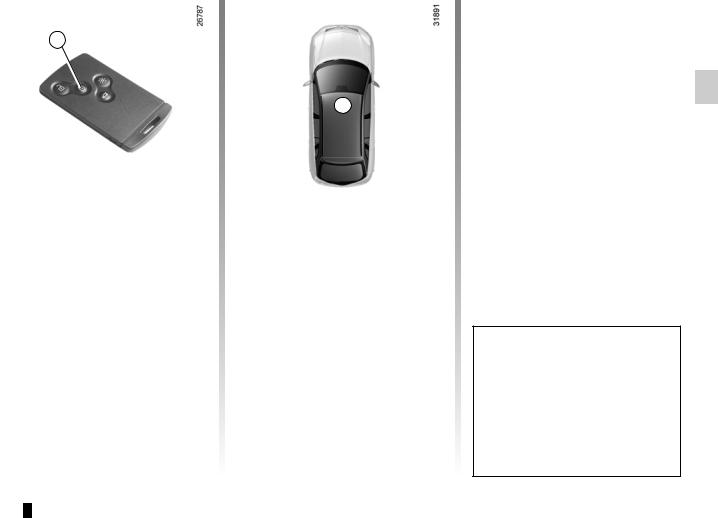
RENAULT "hands-free" card: use (3/3)
6 |
With the engine running, if, after having opened and closed a door, the card is no longer in the passenger compartment, the message “card not detected” (accompanied by a beep when the speed passes a certain level) warns you that the card is no longer in the
7 vehicle. This avoids you driving away after having dropped off a passenger who has the card, for example.
The warning disappears when the card is detected again.
Locking using the RENAULT card
With the doors and tailgate closed, press button 6: the vehicle will lock.
The hazard warning lights flash twice to indicate that the doors have locked.
Note: the maximum distance at which the vehicle locks depends on the surroundings.
Special Note:
The vehicle will not lock if:
–a door or the tailgate is open or not properly closed;
–a card is still in zone 7 (or in the card reader) and no other card is in the external detection zone.
After locking or unlocking the vehicle doors or the tailgate only, using the buttons on the RENAULT card, hands-free unlocking is deactivated.
To reactivate the “hands-free” mode: restart the vehicle.
1.7

RENAULT CARD: deadlocking
2 |
1 |
3 |
If the vehicle is equipped with a deadlocking function, this allows you to lock the opening elements and to prevent the doors from being unlocked using the interior handles (for example, by breaking the window and then trying to open the door from the inside).
Warning: deadlocking is activated the first time
button 1 is pressed.
Never use deadlocking if someone is still inside the vehicle.
To activate deadlocking
Press button 2 or 3 once.
Note: to raise the windows simultaneously, the button must be held down for more than one second.
The hazard warning lights will flash three times to signal deadlocking.
To lock the vehicle, without deadlocking
Press button 2 or 3 twice.
Note: to raise the windows simultaneously, the second time the button is pressed, it must be held down for more than one second.
The hazard warning lights flash twice to indicate that the doors have locked.
To unlock the vehicle
Press button 1.
The hazard warning lights flash once to indicate that the doors have been unlocked.
After activating deadlocking using button 2, “hands-free” unlocking is deactivated.
To reactivate the “hands-free” mode: restart the vehicle.
1.8

Opening and closing the doors (1/2)
1 |
2 |
|
Opening the doors from the outside
With the doors unlocked or the “handsfree” RENAULT card in your possession, hold handle 1 and pull it towards you.
In some cases, it may be necessary to pull the handle twice to open the door.
As a safety precaution, the doors should only be opened or closed when the vehicle is stationary.
Opening from the inside
Pull handle 2 and push the door.
Lights-on reminder buzzer
If you have switched off the ignition and left the lights switched on, a reminder buzzer will sound when a door is opened.
Card reminder buzzer
A beep will let you know if you have left the card in the reader when you open the driver’s door, and the “Remove card” message will appear on the instrument panel.
Special note
After switching off the engine, the lights and some accessories that are in operation (radio, etc.) will continue to operate.
They stop as soon as the driver’s door is opened.
Door/tailgate open buzzer
If a door (or tailgate) is open or not properly closed, as soon as the vehicle reaches a speed of approximately 9 mph (15 km/h), the message “tailgate open” or “door open” (depending on which is open) will appear on the instrument panel accompanied by a warning light.
1.9
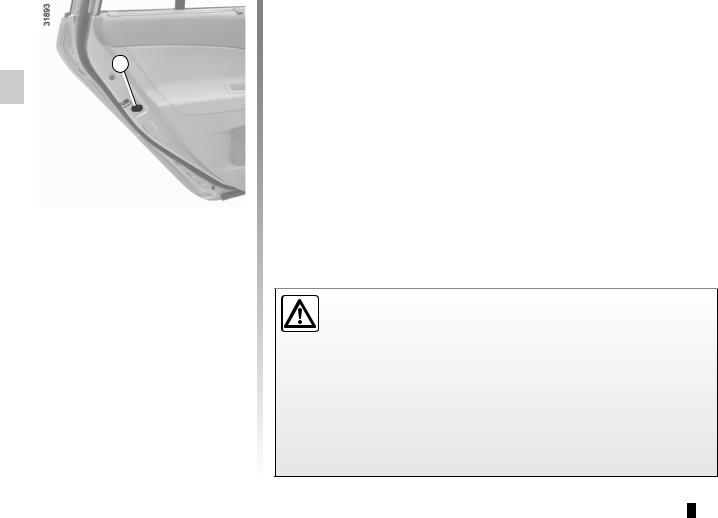
Opening and closing the doors (2/2)
3 |
Child safety
Manually locking the rear doors
Move lever 3 and check from the inside that the doors are securely locked, to prevent the rear doors being opened from the inside.
Driver’s responsibility when parking or stopping the vehicle
Never leave an animal, child or adult who is not self-sufficient alone on your vehicle, even for a short time.
They may pose a risk to themselves or to others by starting the engine, activating equipment such as the electric windows or by locking the doors.
Also, in hot and/or sunny weather, please remember that the temperature inside the passenger compartment increases very quickly.
RISK OF DEATH OR SERIOUS INJURY.
1.10

LOCKING/UNLOCKING THE DOORS (1/2)
Locking/unlocking the doors from the outside
This is done using the RENAULT Card; refer to the information on the RENAULT Card" in Section 1.
In certain cases, the RENAULT card may not work:
–when the RENAULT card battery is drained, flat battery, etc.
–use of appliances operating on the same frequency as the card (mobile phone, etc.);
–vehicle located in a high electromagnetic radiation zone.
It is then possible:
–to use the key integrated into the card to unlock the front left-hand door;
–to lock each of the doors manually (see the following page);
–to use the interior door locking/unlocking control (refer to the following pages).
A |
1 |
2 |
Using the key integrated in the RENAULT card
–Take out the integrated key (refer to the section on “RENAULT cards: general information" in section 1) ;
–remove cover A from the left-hand door (using the end of key 2) in notch 1;
–move it upwards to remove cover A;
–insert the key 2 into the lock in the front left-hand door and lock or unlock.
3 |
Locking the doors manually
Turn screw 3 with the door open (using the end of the key) and close the door.
This means that the doors are then locked from the outside.
The doors may then only be opened from the inside or by using the key in the front left-hand door.
1.11

LOCKING/UNLOCKING THE DOORS (2/2)
4 |
Interior locking/unlocking door control
The switch 4 simultaneously controls the doors and the tailgate.
If a door or the tailgate is open or not closed properly, the doors and tailgate lock/unlock quickly.
If transporting an object with a door or tailgate open: with the engine stopped, press the switch 4 for more than five seconds to lock the other opening elements.
Locking the opening elements without the RENAULT card
(if the RENAULT card is not working, for example)
With the engine switched off and a front door open, press switch 4 for more than five seconds.
When the door is closed, all the doors and the tailgate will be locked.
Unlocking the vehicle from the outside will only be possible with the RENAULT card.
Driver’s responsibility
Never leave your vehicle with the RENAULT card inside.
Doors and tailgate status indicator light
When the ignition is on, the indicator light integrated in switch 4 informs you of the status of the doors and tailgate:
–indicator light on, the doors and tailgate are locked;
–indicator light off, the doors and tailgate are unlocked.
When you lock the vehicle from the outside, the indicator light remains lit for approximately one minute, then goes out.
Driver’s responsibility
 If you decide to keep the doors locked when you are driving, remember that it may be more difficult for those as-
If you decide to keep the doors locked when you are driving, remember that it may be more difficult for those as-
sisting you to gain access to the passenger compartment in the event of an emergency.
1.12

RAID (Renault Anti-Intruder Device)
1 |
Operating principle
When the vehicle is started, the system automatically locks the doors when the vehicle reaches approximately 6 mph (10 km/h).
The door can be unlocked:
–by pressing door unlocking button 1.
–by opening a front door (vehicle stationary).
Note: if a door is opened or closed, it will automatically lock again when the vehicle reaches a speed of 6 mph (10 km/h).
To activate this function:
After switching on the ignition and when the vehicle is stationary, you have approximately 20 seconds to press and hold door locking switch 1 (for approximately 5 seconds).
The message “automatic door locking activated” is displayed on the instrument panel and a beep sounds.
To deactivate this function:
After switching on the ignition and when the vehicle is stationary, press and hold door locking switch 1 for approximately 5 seconds.
The message “automatic door locking deactivated” is displayed on the instrument panel and a beep sounds.
Driver’s responsibility
 If you decide to keep the doors locked when you are driving, remember that it may be more difficult for those as-
If you decide to keep the doors locked when you are driving, remember that it may be more difficult for those as-
sisting you to gain access to the passenger compartment in the event of an emergency.
Operating faults
If you experience an operating fault (no automatic locking, the indicator light incorporated in button 1 does not light up when trying to lock the doors and tailgate, etc.), firstly check that the doors and tailgate are properly closed. If they are closed correctly, contact an approved dealer.
1.13

FRONT HEADRESTS
A
1 |
To raise the headrest
Pull the headrest upwards to the desired height.
To lower the headrest
Press button 1 and guide the headrest down to the desired height.
Adjusting the angle of the headrest
(depending on vehicle)
Tilt the headrest A forwards or backwards to the required position.
To remove the headrest
Raise the headrest as far as possible, then while pressing button 1, raise the headrest to release it.
To refit the headrest
Insert the headrest rods into the holes, with the notches facing forwards.
Hold down button 1 and move the headrest to the required height.
The headrest is important for safety. Ensure that it is in place and in the correct position: the top of the head-
rest should be as close as possible to the top of the head and there must be a minimal distance between the head and the A headrest.
1.14

REAR HEADRESTS
A A
1 |
2 |
Position for use
Raise or lower the headrest while pulling it towards the front of the vehicle.
Storage position A
Press tab 1 or 2 and lower the headrest completely.
When the headrest is set at the lowest position, this is for storage only: it should not be in this position when a seat is occupied.
To remove the headrest
Press tabs 1 and 2 simultaneously and remove the headrest.
To refit the headrest
Slide the headrest rods into the holes, press tabs 1 and 2 simultaneously and lower the headrest.
Note: to remove or refit the headrest, the seatback must be tilted. Refer to “Rear bench seat” in Section 3.
The headrest is an important safety component. Ensure that it is fitted and positioned correctly.
1.15
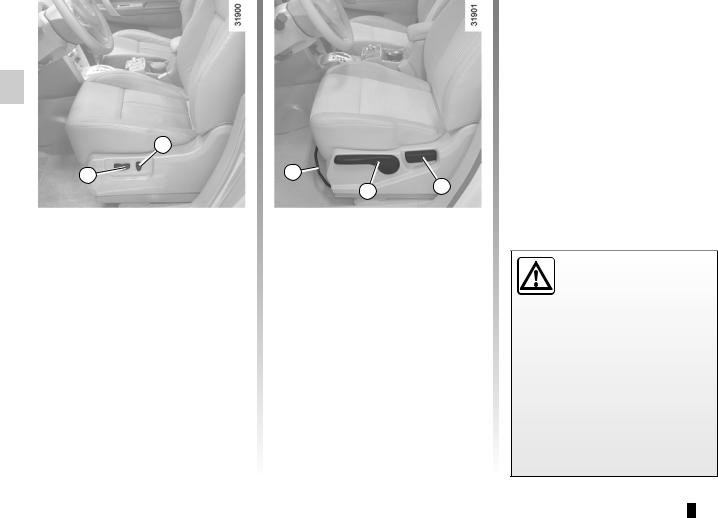
Front seats (1/2)
2 |
1 |
Driver’s seat with electric controls
To move the seat forwards or back
Move switch 1 forwards or backwards.
To raise or lower the seat base
Move the rear of switch 1 upwards or downwards.
To tilt the seatback
Move the rear of switch 2 forwards or backwards.
3 |
5 |
4 |
Front seat with manual controls
To move the seat forwards or back
Lift handle 3 to release. Release the handle at the desired position and make sure that it is locked.
To raise or lower the seat base
(depending on vehicle) Move lever 4 as required:
–move it upwards to raise the seat;
–move it downwards to lower the seat.
To tilt the seatback
Move lever 5 to control the angle of the seatback.
For safety reasons, make these adjustments only when the vehicle is station-
ary.
We would advise you not to recline the seatbacks too far to ensure that the effectiveness of the seat belts is not reduced.
Nothing should be placed on the floor (area in front of driver) as such objects may slide under the pedal during braking manoeuvres, thus obstructing its use.
1.16

FRONT SEATS (2/2)
6 |
To fold down the passenger seat
Depending on the vehicle, the passenger seatback may be folded down onto the seat base to create a table.
Lift handle 6 and lower the seatback.
7 |
To adjust the lumbar support on the driver’s seat:
Move lever 7.
Since front passenger airbag operation and the position of a front passenger seatback table are incompatible, ensure that the airbag is deactivated. (Refer to the information on “Front passenger air bag activation/
deactivation” in Section 1).
There is a risk of very serious injury if the air bags deploy.
When driving, rear passengers must not place their feet on the seatback of the front seats under any circumstances. Risk of injury.
8 |
Heated seats
(depending on vehicle)
With the engine running, press switch 8, pressing on the top of the switch (to select the warmest setting) or the bottom of the switch (to select the average setting).
The indicator light on the button lights up.
The system, which has a thermostat, decides whether or not the heating is needed, according to the position selected.
If the heated front passenger seat is ac-
tivated, the indicator light Ðlights up on the instrument panel.
1.17
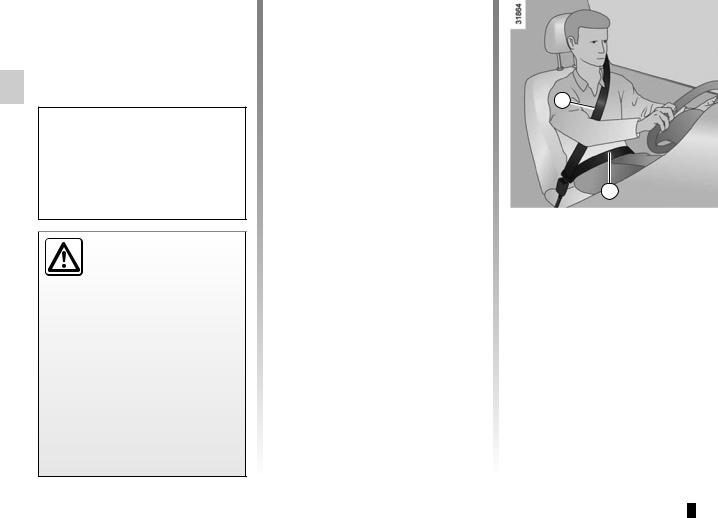
SEAT BELTS (1/2)
Always wear your seat belt when travelling in your vehicle. You must also comply with the legislation of the particular country you are in.
Make sure that the rear bench seat is securely locked in position so that the rear seat belts will operate efficiently. Refer to “Rear bench seat” in Section 3.
Seat belts which are incorrectly adjusted or twisted may cause injuries in the
event of an accident.
Use one seat belt per person, whether child or adult.
Even pregnant women should wear a seat belt. In this case, ensure that the lap belt is not exerting too much pressure on the abdomen, but do not allow any slack.
Before starting, first adjust your driving position, then ask all occupants to adjust their seat belts to ensure optimum protection.
Adjusting your driving position
–Sit well back in your seat (having first removed your coat or jacket). This is essential to ensure your back is positioned correctly;
–adjust the distance between the seat and the pedals. Your seat should be as far back as possible while still allowing you to depress the clutch pedal fully. The seatback should be adjusted so that your arms are slightly bent when you hold the steering wheel;
–adjust the position of your headrest. For maximum safety, your head must be as close as possible to the headrest;
–adjust the height of the seat. This adjustment allows you to select the seat position which offers you the best possible view;
–adjust the position of the steering wheel.
1 |
2 |
Adjusting the seat belts
Sit with your back firmly against the seatback.
The shoulder strap 1 should be as close as possible to the base of the neck but not on it.
The lap strap 2 should be worn flat over the thighs and against the pelvis.
The belt should be worn so that it is as close as possible to your body, i.e.: avoid wearing heavy clothing or keeping bulky objects under the belts, etc.
1.18

SEAT BELTS (2/2)
1 |
5 |
3 |
4 |
|
5 |
|||
|
|
Fastening
Unwind the belt slowly and smoothly and ensure that buckle 3 locks into catch 5 (check that it is locked by pulling on buckle 3). If the belt jams, allow it to return slightly before attempting to unwind it again.
If your seat belt is completely jammed, pull slowly, but firmly so that just over 3 cm unwinds. Allow it to return slightly before attempting to unwind it again.
If there is still a problem, contact an approved dealer.
6 |
7 |
™Front passenger seat belt reminder warning light
This lights up when the engine is started on the instrument panel 6 or on the centre console 7 if the front passenger seat belt (if this seat is occupied) is not fastened and the vehicle has reached approximately 15 mph (25 kph); it flashes and a bleep sounds for approximately 90 seconds.
Note: an object placed on the passenger seat base may activate the warning light in some cases.
Unfastening
Press button 4 and the seat belt will be rewound by the inertia reel. Guide the belt.
8 |
Adjusting the height of the front seat belts
Press button 8 to adjust the seat belt height so that the shoulder strap 1 is worn as shown previously:
–to lower the seat belt, press button 8 and lower the seat belt at the same time;
–to raise the seat belt, press button 8 and raise the seat belt at the same time.
Make sure that the seat belt is locked in position correctly after you have adjusted it.
1.19

REAR SEAT BELTS
2 |
1 |
3 |
Side seat belt
Hold the buckle 1 and pull slowly on the belt.
Place the upper section of the belt as close to your shoulder as possible and the lower section as close to your pelvis as possible.
Click buckle 1 into the catch 3.
Note: feed the side seat belts into the clips 2 when they are not being used.
5 |
4 |
|
Centre seat belt
Hold the buckle 4 and pull slowly on the belt.
Place the upper section of the belt as close to your shoulder as possible and the lower section as close to your pelvis as possible.
Click buckle 4 into the catch 5.
Check that the rear seat belts are correctly positioned each time the rear bench seat is moved.
1.20

SEAT BELTS: warnings
The following information applies to the vehicle’s front and rear seat belts.
– No modification may be made to the component parts of the originally fitted restraint system: belts, seats and their mountings. For special operations (e.g. fitting child seats) contact an authorised dealer.
– Do not use devices which allow any slack in the belts (e.g. clothes pegs, clips, etc.): a seat belt which is worn too loosely may cause injury in the event of an accident.
–Never wear the shoulder strap under your arm or behind your back.
–Never use the same belt for more than one person and never hold a baby or child on your lap with your seat belt around them.
–The belt should never be twisted.
–Following an accident, have the seat belts checked and replaced if necessary. Always replace your seat belts as soon as they show any signs of wear.
–When repositioning the rear bench seat, make sure that the seat belt is correctly positioned so that it can be used properly.
–Make sure that the buckle is inserted into the appropriate catch.
–Ensure that no objects are placed in the area around the seat belt catch as they could prevent it from being properly secured.
1.21

METHODS OF RESTRAINT IN ADDITION TO THE FRONT SEAT BELTS (1/4)
Depending on the vehicle, they are composed of:
–seat belt inertia reel pretensioners 1;
–lap belt pretensioner 2;
–air bags for driver and front passenger 3.
These systems are designed to act independently or together when the vehicle is subjected to a frontal impact.
The following systems will be triggered according to the level of impact force:
–seat belt locking;
–the seat belt inertia reel pretensioner (which engages to correct seat belt slack);
–the lap seat belt pretensioners to hold the occupant in his seat;
–the front air bag.
3 |
2 |
1 |
Pretensioners
The pretensioners flatten the belt against the body, holding the occupant against the seat, thus improving the efficiency of the belt.
In the event of a severe frontal impact and if the ignition is switched on, the system may engage the following depending on the force of the impact:
–the seat belt inertia reel pretensioner 1 which instantly retracts the seat belt;
–the lap belt pretensioner 2 which instantly retracts the lap belt.
– Have the entire restraint system checked following an accident.
– No operation whatsoever is permitted on any part of the system (pretensioners, air bags, computers, wiring) and the system components must not be reused on any other vehicle, even if identical.
–To avoid incorrect triggering of the system which may cause injury, only qualified personnel from an approved dealer may work on the pretensioner and air bag system.
–The ignition module electrical specifications may only be tested by a specially trained technician using special equipment.
–When the vehicle is scrapped, contact an approved dealer for disposal of the pretensioner and air bag gas generators.
1.22

METHODS OF RESTRAINT IN ADDITION TO THE FRONT SEAT BELTS (2/4)
Force limiter
Above a certain level of impact force, this mechanism is used to limit the force of the belt against the chest so that it is at an acceptable level.
Air bags for driver and front passenger
An “airbag” marking on the steering wheel and the dashboard (airbag area A) indicates that this device is fitted.
Each air bag system consists of:
–an air bag and gas generator fitted on the steering wheel for the driver and in the dashboard for the front passenger;
–an intelligent computer for both systems, which includes an impact sensor and a monitor controlling the electrical trigger system for the gas generator;
–a single indicator light Åon the instrument panel;
–remote sensors for the device.
A
The air bag system operates using the principles of pyrotechnics. This explains why, when the air bag in-
flates, it will generate heat, produce smoke (this does not mean that a fire is about to start) and make a noise upon detonation. In a situation where an air bag is required, it will inflate immediately and this may cause some minor, superficial grazing to the skin or other problems.
1.23

METHODS OF RESTRAINT IN ADDITION TO THE FRONT SEAT BELTS (3/4)
Operation
This system is only operational when the ignition is switched on.
In a severe frontal impact, the air bags inflate rapidly, cushioning the impact of the driver’s head and chest against the steering wheel and of the front passenger against the dashboard. The air bags then deflate immediately so that the passengers are not in any way hindered from leaving the vehicle.
4 |
Operating faults
Warning light 4 will light up on the instrument panel when the ignition is switched on and then go out after a few seconds.
If it does not light up when the ignition is switched on, or lights up while the engine is running, there is a fault in the system (air bags, pretensioners etc.).
Contact your approved dealer as soon as possible. Your protection will be reduced until this fault is rectified.
1.24
